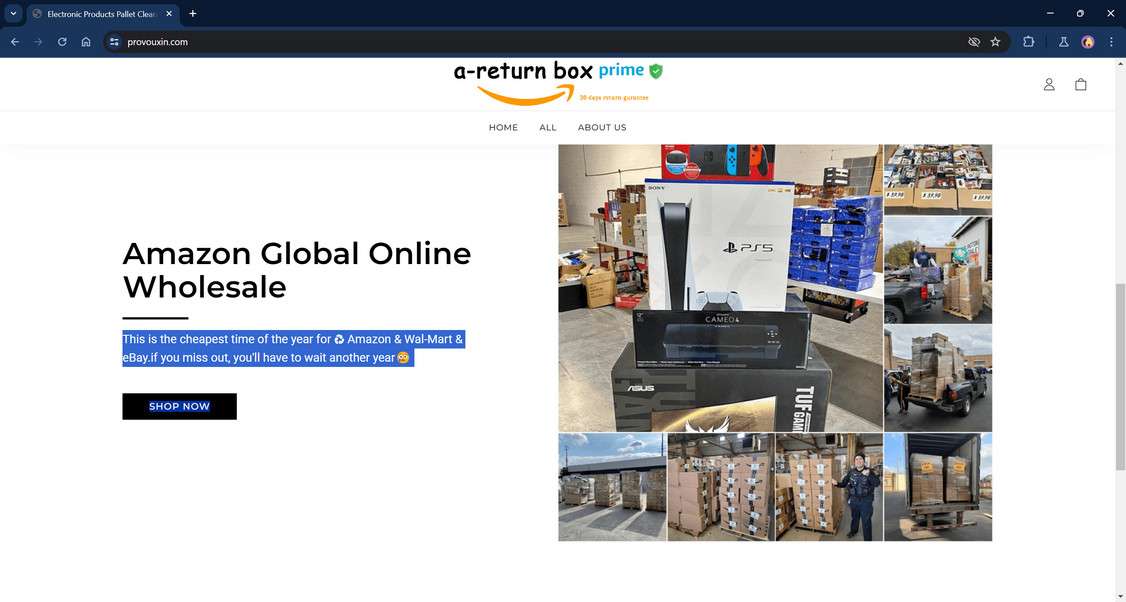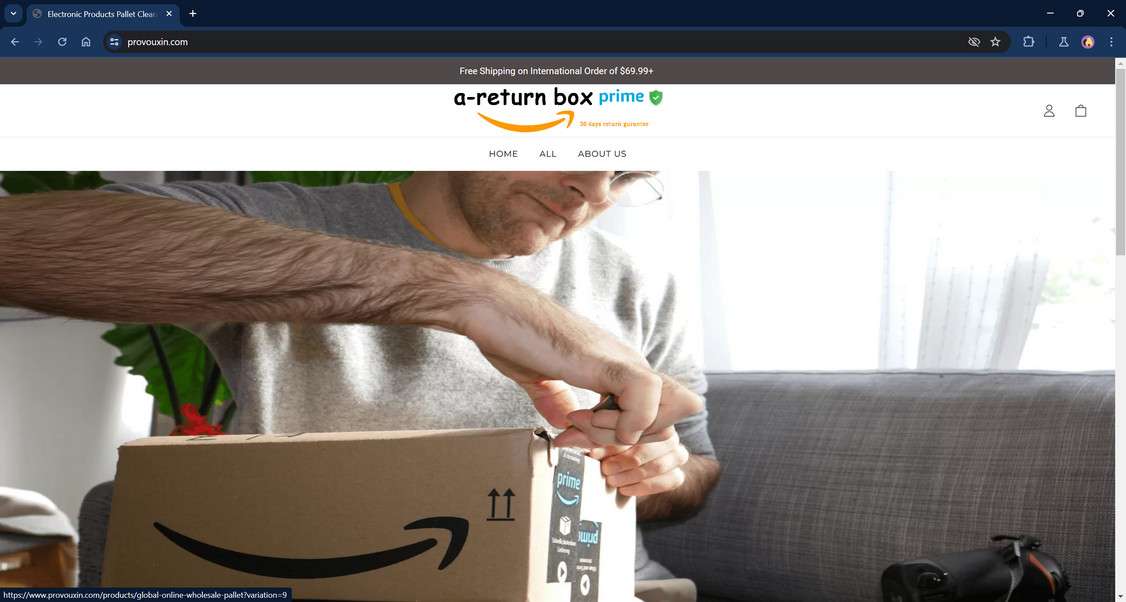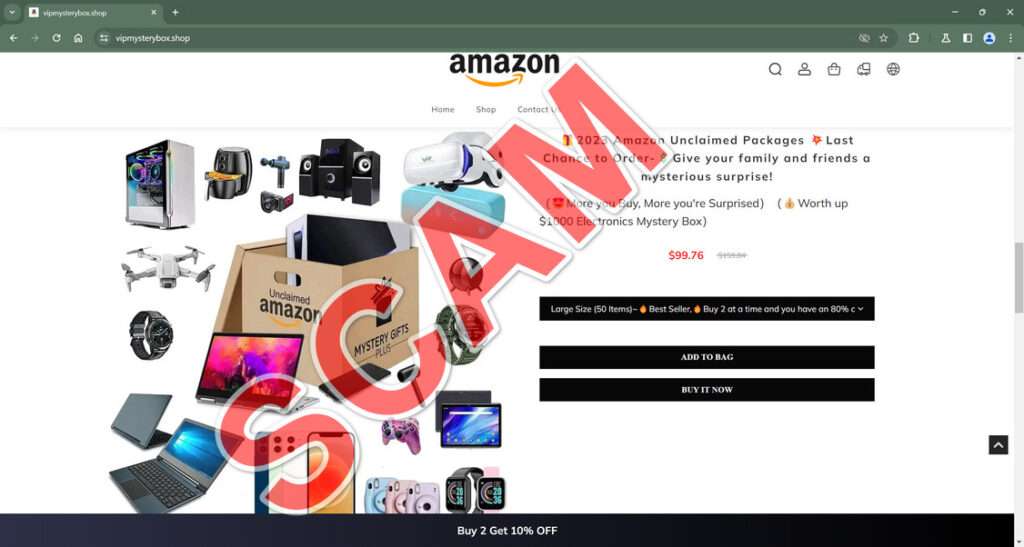A new incarnation of the Amazon pallets scam has emerged on social platforms recently. Scammers are now using sponsored ads about “Amazon Global Online Wholesale Pallets” to lure victims into the same trap. These ads are appearing on Facebook, Instagram, YouTube, TikTok and Google search results. They continue preying on shoppers’ desires to score big discounts on returned Amazon merchandise. However, the pallet contents never match the extravagant claims and promises.
This article will examine how the Amazon Global Online Wholesale Pallet scam operates, provide tips for spotting their deceptive techniques, outline steps for victims, and raise awareness to help consumers avoid being defrauded.


This Article Contains:
Overview of the Amazon Global Online Wholesale Pallet Scam
A new form of scam has proliferated lately involving social media advertisements for pallets of wholesale Amazon merchandise. Criminals are baiting users with sponsored posts showcasing pallets stuffed with returned electronics, gadgets and tools supposedly sourced directly from Amazon at rock bottom prices ranging from $39 to $99. However, customers who purchase these mystery pallets receive nothing even close to what was depicted and promised.

The social media ads link to elaborate fake ecommerce websites designed to closely impersonate Amazon’s real site. Users are prompted to buy the pallets of wholesale overstock items without seeing the exact contents. After entering personal and payment information, the criminals behind the sites pocket the money and data, never sending the promised products. Some victims report receiving nearly worthless items like cheap sunglasses or rings that cost a couple dollars at most to source. Others have found themselves subscribed to recurring monthly charges without consent after engaging with the fake sites. But the overwhelming majority say their orders never arrived at all.
These schemers are exploiting interest in discounted Amazon returns just like the prior iterations of the “Amazon pallets” scam covered previously. Social platforms have tried reducing the reach of these fraudulent offers in feeds and search results. However, the criminals find new ways to target victims by mimicking legitimate sellers and manipulating algorithms. Their sophisticated techniques make these online scams harder to distinguish from real deals without proper due diligence.
The accounts promoting the scam ads pose as bulk resalers or wholesalers clearing out Amazon overstock pallets, using terms like “liquidation” and “clearance”. To make them appear more legitimate, the posts contain dubious backstories about obtaining the pallets directly from Amazon after settling debts or dealing with excess inventory. Some even claim to be Amazon themselves, advertising pallets from the “Amazon Warehouse Sale”.
The promise of scoring $500+ worth of gadgets and tools for only $59 is highly alluring. Curiosity is piqued, driving users to click on these social media ads in droves. The number of victims indicating they engaged with the fraudulent sites after seeing the posts demonstrates these clickbait ads are hooking consumers efficiently.
Once on the fake ecommerce stores, even savvy online shoppers can be fooled. The criminals managing these storefronts invest heavily in web developers to make them look as authentic as possible. The branding, layout, product listings, payment processing, and even the URLs are nearly indistinguishable from real Amazon at first glance. Some sites even have extensive fake product reviews, customer service chat bots, and account profile pages that mimic Amazon’s actual features and site architecture.
These convincing fakes successfully dupe victims into inputting their names, home addresses, phone numbers, and credit card details because it appears no different than making a real purchase on Amazon. That personal information is then immediately harvested and either used to make future unauthorized transactions or sold to other cybercriminal groups.
The victims report noticing the charges on their statements but rarely do any of the promised pallet merchandise actually arrive. Some banks will initially decline fraud claims against these sites because on the surface they seem legitimate. Countless users have found themselves losing cash with absolutely no recourse after the fake companies disappear without a trace.
These scam operations tenure is purposefully short-lived to evade detection. They steal what they can in a small period of time, then shutter sites and accounts before authorities or media can catch on. But they simply recycle the stolen data to form new entities under different guises and resume their illegal enterprise. Until consumers get better at identifying their deceptive techniques, these actors will continue profiting immensely off social media users. Do not become the next victim who learns about this scam the hard way.
How the Amazon Global Online Wholesale Pallet Scam Works
Sophisticated cybercriminal networks have developed a smooth process for executing this scam:
Step 1: Posting Enticing Social Media Ads
The scam starts with sponsored social media ads promoting the wholesale pallets using convincing photos of electronics and other valuable merchandise. Many ads mimic Amazon’s own marketing language and brand style. This grabs users’ attention, prompting them to click to shop.
Step 2: Directing Victims to Fake Ecommerce Stores
Clicking the link sends victims to fake sites nearly identical to Amazon’s real website. The only giveaway is the URL, often containing variations of “AmazonGlobal” or “Amazon-Wholesale”. The sites have the same logos, products listings, reviews and account tools to trick users.
Step 3: Collecting Personal and Payment Information
The fake sites prompt visitors to purchase a pallet without seeing exact contents. Users must enter a name, address, phone number and credit card information, which the scammers capture for fraudulent purposes.
Step 4: Charging Cards but Never Delivering Promised Products
Victims who place orders have their cards billed immediately. However, the pallet contents promised never arrive. Most report receiving absolutely nothing from these fake sellers.
Step 5: Vanishing Without a Trace
When victims inevitability try contacting the fake sellers about never receiving their orders, they find no way to reach them. The sites and any email addresses associated with them disappear quickly. Victims cannot get refunds or even track down the scammers.
Step 6: Repeating the Process Under New Guises
These scam networks are ephemeral by design. They pop up, harvest data and payments from as many victims as possible, then disband before authorities catch on. But they reuse stolen data to form new scam entities in a never-ending cycle.
This illegal enterprise continues enjoying immense profits from defrauded social media users. Education and recognizing their techniques remain the best defenses. Do not become their next victim.
What to Do if You Are Scammed by Amazon Global Online Wholesale Pallets
If you unfortunately fell prey to the social media ads and fake websites for Amazon Global Online Wholesale Pallets, take these steps immediately:
Step 1: Report Fraudulent Charges to Your Credit Card Company
Contact your credit card provider to dispute the charges and request a chargeback. Provide details about the scam site and ad. Acting swiftly can increase chances of getting money refunded.
Step 2: File a Complaint with the FTC
Submit a scam report to the Federal Trade Commission so they can investigate the fraudulent sites and social media accounts. This helps authorities build cases against the scammers.
Step 3: Monitor Your Credit Reports and Accounts
Keep close watch for any signs of identity theft or further unauthorized charges. Often scammers harvest data to commit additional fraud.
Step 4: Report Fake Ads and Sites to Social Platforms
Report the scam ads and fake sites to platforms like Facebook, Instagram, YouTube and TikTok so they can remove them. Prevent the scammers from targeting more victims.
Step 5: Spread Awareness About This Scam
Post warnings about this scam on social media and tell your friends and family about it. Share this article and others to make more consumers aware of these deceptive tactics.
With vigilance and education, we can reduce the spread of ecommerce scams conducted through social platforms.
Key Ways to Identify Amazon Global Online Wholesale Pallet Scams
While these criminals are creative in disguising their false offers, these telltale signs can help spot their scam sites and social media ads:
Sketchy Origins Story in the Ad Copy
The ads contain dubious backstories about obtaining wholesale pallets directly from Amazon. Stories of “settling debts” or “overstock” from Amazon cannot be verified.
URL Contains “AmazonGlobal” or Variations
While mimicking Amazon’s site the URL gives it away, often using “AmazonGlobal” or “AGO-Wholesale”.
Too-Good-to-Be-True Pricing
Authentic wholesale sources do not offer pallets with $500+ worth of merchandise for $39. Discounts over 90% indicate a scam.
Limited Stock or Time Pressure
Scarcity claims of “only 7 pallets left!” or “sale ending soon!” create false urgency to purchase without scrutiny.
No Verified Contact Information
No working phone number, physical address or customer service options are provided by the seller.
Missing Return Policy and Lack of Refund Options
Scam sites do not offer clear return or refund policies to protect consumers. This lack of recourse is a warning sign.
Poor Privacy and Security
No SSL certificate or https secure site protocol. Grammatical errors and typos indicate amateur sites.
Too New to Be Verified Elsewhere
Researching the site name yields no history or reputation. Newly formed sites warrant deeper scrutiny before engaging.
With knowledge of these red flags, savvy shoppers can steer clear of these social media scams impersonating Amazon wholesale suppliers.
Protecting Yourself From Amazon Global Online Wholesale Pallet Scams
While authorities work to disrupt these networks, consumers should exercise caution and consider these proactive measures:
- Carefully research any unfamiliar sites advertising unbelievable deals before providing payment or personal information. Search the company name plus words like “scam” or “complaint” to uncover issues.
- Review any social media ads critically. Fake accounts often have stock images and minimal followers or posts. Click links could redirect to completely unrelated sites.
- Never provide personal or payment data on sketchy sites found via social media ads, especially without reading policies and reviews first. Information could easily be misused or stolen.
- Only use secure payment options that offer fraud protection when purchasing online. Avoid direct bank transfers or gift cards which seldom can be recovered if stolen by scammers.
- Monitor financial statements routinely for any unauthorized charges and report them immediately. Enable text or email alerts on cards to spot irregular activity faster.
- Manage privacy settings on social media to limit what ads can target you based on data brokers. Reduce chances of seeing fraudulent offers.
Staying informed on the latest online scams can prevent heartache and financial loss. Share this knowledge with others to curb the spread of deceptive tactics targeting consumers.
Legitimate Liquidation Sites vs. Scam Social Media Ads
While fraudulent, some of the social media ads for Amazon Global Online wholesale pallets try to seem credible by claiming the inventory is liquidated directly from Amazon. However, there are crucial differences between legitimate wholesale liquidators and these scam ads.
Some companies do actually work directly with Amazon to acquire pallets of customer returns, expired inventory, and other excess products to resell at discount. But these legitimate wholesale liquidators predominantly work on a business-to-business model, selling bulk pallets through live auctions or direct marketing to verified resellers.
For instance, liquidation leader B-Stock Solutions partners with major retailers and brands, including Amazon, to manage their returns and overstock. But B-Stock deals strictly in bulk sales to qualified business buyers who can inspect merchandise in person before bidding in live auctions. They do not sell direct to consumers or advertise on social media.
Whereas the Amazon Global Online scam ads target ordinary social media users with little recourse after engaging with the fraudulent pages and websites. Legitimate wholesale liquidators vet their buyers and provide extensive consumer protections that these social media scams lack entirely.
While some legitimate businesses exist in the liquidation space, exercise extreme caution with social media ads offering unbelievable deals on mystery pallets. Scrutinize where the links lead and research any unfamiliar companies being promoted. If something seems fake, it likely is. Transparency and accountability separate scams from lawful commerce.
Frequently Asked Questions About the Amazon Global Online Wholesale Pallet Scam
1. What is the Amazon Global Online Wholesale Pallet scam?
This scam involves social media ads for pallets of wholesale Amazon returns from “Amazon Global Online” at $39-$99. The ads promise valuable electronics, gadgets and tools, but victims receive nothing close to advertised after entering payment info into fake sites.
2. Where do the scam ads appear?
The ads appear on Facebook, Instagram, YouTube, TikTok and Google searches. Scammers use sponsored posts and target keywords related to Amazon and pallets.
3. What techniques do the scammers use?
They create fake sites impersonating Amazon with near-identical branding, design and product listings. Fake social accounts and backstories promote the ads. Stolen data helps quickly setup new scam operations to avoid detection.
4. What happens if you click on an ad?
H3: The ads redirect to elaborate fake sites cloning Amazon’s real website. Users are prompted to purchase mystery pallets by entering personal and payment data which the criminals capture.
5. What do the ads promise will be in the pallets?
The ads tout expensive electronics, smart gadgets, premium tools and more from top brands. Photos show items like iPads, 4K TVs, PlayStation 5s, iRobot vacuums and Milwaukee power tools.
6. What do victims really receive from the orders?
Most victims report never receiving any shipment at all. Some receive nearly worthless items like cheap pens costing a few dollars. Many find unauthorized monthly charges from the scammers on their cards after engaging.
7. How can I identify these scam ads and sites?
Look for too-good-to-be-true pricing, dubious backstories about Amazon overstock, site URLs containing “AmazonGlobal”, no contact info, missing policies, and other red flags.
8. What should I do if I was scammed?
Contact your credit card company to dispute the charges. Report the fraud to the FTC to aid investigations. Monitor your credit and accounts closely for any signs of identity theft.
9. How can I avoid this scam?
Carefully research unfamiliar sites and social media ads before providing any personal or payment data. Search for reviews and complaints. Avoid sites that seem fake or cannot be verified.
10. How can I report these scams?
Report scam ads and sites to relevant social media platforms so they can be removed. Submit details to the Better Business Bureau and FTC to get fraudulent companies and accounts shut down.
The Bottom Line on the Amazon Global Online Wholesale Pallet Scam
The bottom line is consumers should exercise extreme caution about mystery pallet offers on social media advertising impossible discounts on expensive merchandise. Most are scams aiming to pilfer payment details and personally identifiable information, not actually deliver goods to you. These networks exploit the Amazon brand because it lends them automatic legitimacy in many users’ minds.
If you engage with the ads or fraudulent websites, chances are high you will lose any money paid while receiving nothing of value in return. Worse still, these criminals may continue using your stolen data for identity theft or re-selling it on dark web marketplaces. Their slick ecommerce storefronts and social media presence allow them to operate largely with impunity for the time being.
While authorities must continue working to disrupt these schemes, public awareness is the best recourse currently. Exposing their tactics and shutting down their social media accounts can reduce victims. If we maintain healthy skepticism before interacting with unbelievable deals online, far fewer will get caught in this insidious trap. Share your knowledge with others to help protect against growing retail scams on popular platforms.










